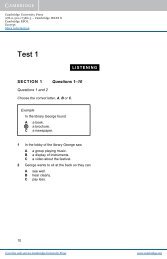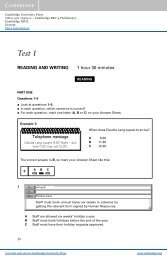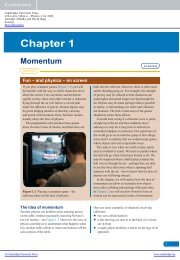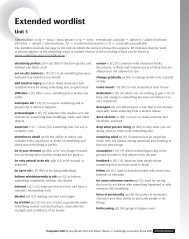Skills for Study Level 2 Teacher's Book - Cambridge University Press
Skills for Study Level 2 Teacher's Book - Cambridge University Press
Skills for Study Level 2 Teacher's Book - Cambridge University Press
Create successful ePaper yourself
Turn your PDF publications into a flip-book with our unique Google optimized e-Paper software.
Suggested answersFigure 18 presents the results of a survey investigating people’s reasons<strong>for</strong> leaving their previous job. Over a thousand men and women aged 15–65participated. The results focus on common reasons <strong>for</strong> leaving a job, such assickness and disability, retirement, leaving to have or care <strong>for</strong> children, comingto the end of a contract, or being fired. The only category in which women aremore represented than men is leaving <strong>for</strong> childbirth or childcare. Perhaps someof these women re-enter the work<strong>for</strong>ce, but it is interesting to note that eighttimes as many women as men decided to leave their job when children arrived.The large difference between the sexes in this category may account in part <strong>for</strong>the lower representation of women in the other categories. Men were twice aslikely to leave through ill health and a third more likely to have retired from theirlast job. Women are traditionally less likely to work in occupations which areassociated with illness or disability, such as heavy industry. They are also lesslikely to continue working until they reach retirement age. Perhaps the mostinteresting result is that men are twice as likely to have been fired from theirlast job. The reasons <strong>for</strong> this are not certain, but perhaps men are more likelythan women to be over-confident in their own abilities and there<strong>for</strong>e more likelyto apply <strong>for</strong> jobs that they are incapable of doing well.In Figure 19 we can see relative labour <strong>for</strong>ce participation rates <strong>for</strong> menand women in the UK between the years 1980 and 2008. The graphic clearlyshows us two things: firstly, that a higher percentage of working-age menwere employed in the work<strong>for</strong>ce during those years compared to women.In 1980, <strong>for</strong> instance, just under 90% of working-age men were actually inemployment, compared to just over 55% <strong>for</strong> women. However, what the graphalso indicates is that the gap is narrowing: the percentage of working-age menin the population declined steadily during the period, while there was a steadyrise in the percentage of working-age women so that, in 2008, just over 80% ofmen were employed, compared with nearly 70% of women. But what explainsthese changing trends in employment? We can see that the change has beenmore marked <strong>for</strong> women: the percentage of men in the work<strong>for</strong>ce declined byonly about 7% between 1980 and 2008, whereas the percentage of women roseby about 14% during the same period, with a particularly noticeable increasebetween 1984 and 1988. It’s possible that social attitudes to women at workbegan to change during this time, with more women seeking employment thanchoosing to remain in more traditional roles in the home.3e Students work with a partner who chose a different graphic, and take turnspresenting their graphics to each other.3f Group discussionUnit 1 Part D ∙ Reporting in speech 29
















